Whether you want to sell hundreds of 3D printed articulated dragons at craft fairs, offer your 3D printed shop tools online, or establish a print-on-demand service unit at your company, you’re going to need a lot of printers. Today, 3D printers are more reliable and automated than ever, and workflow software to manage your print jobs makes volume 3D printing exponentially more efficient.
No one knows who first coined the term “3D print farm,” but like a server farm or a solar farm, it fits perfectly. This setup, where multiple 3D printers are organized and operated together in one location, is designed to increase production capacity, speed, and efficiency. Whether it’s 10 printers or 400, operated by an entrepreneur or an enterprise, 3D printer farms enable you to churn out dozens or thousands of products a week.
Costing just a few hundred to a few thousand dollars each, 3D printers offer a low barrier to entry for manufacturing, but that doesn’t mean setting up a print farm comes without the usual business pitfalls.
Here, we’ll look at the top 3D printers for print farms and give you plenty of tips for setting it up and keeping it running smoothly. You’ll also want to calculate if using a print service instead of setting up your own farm is ultimately the better option.
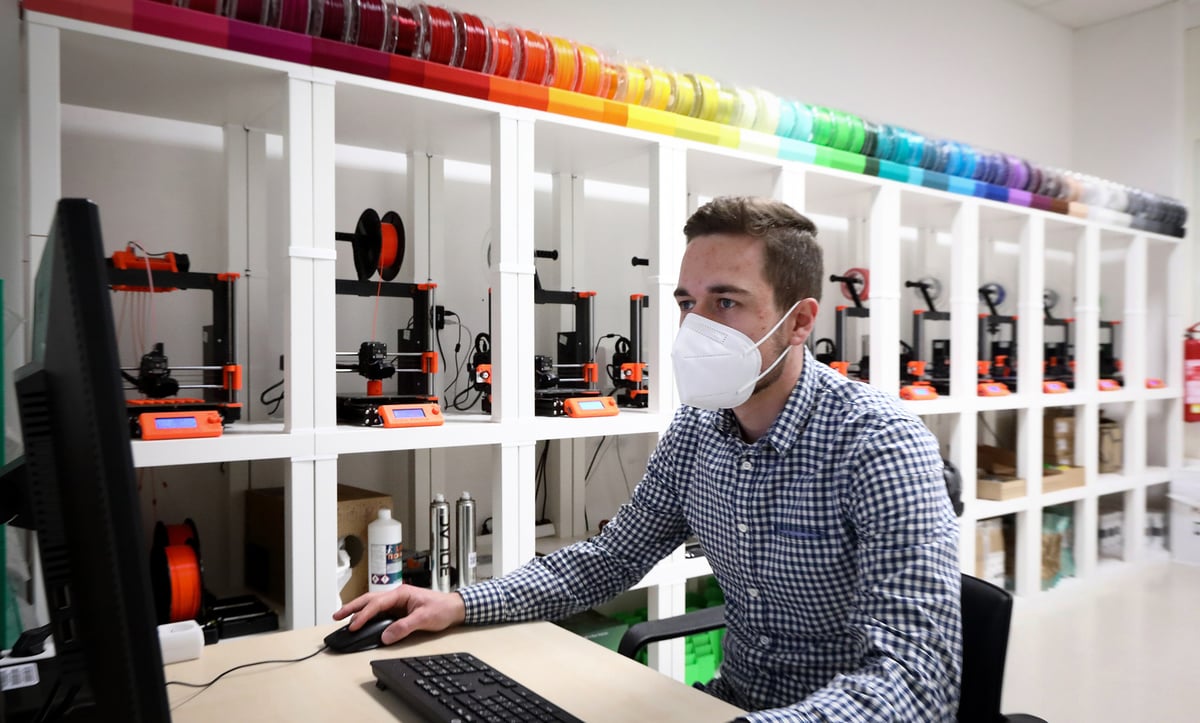
More Farms Today Than Ever
“We’ve absolutely seen an uptick in customers purchasing 10 or more 3D printers to establish print farms,” says Dave Gaylord, VP of products and technology at MatterHackers, the large US-based 3D printer reseller. “Customers from aerospace to architecture, contract manufacturing to automotive, home-based Etsy shops, and even schools are taking advantage of the low cost and high return of 3D printing to do batch production of parts.”
Gaylord says this trend underscores a new level of reliability and efficiency in today’s 3D and also the wide variety of materials available, like carbon-fiber-filled nylon and filament for metal parts.
3D printer maker Prusa Research, a popular choice for print farms, also says it sees a significant increase in multi-printer orders. “As 3D printing has become an essential part of many industries’ workflows, the average number of printers within a single organization is rapidly increasing,” says Mikolas Zuza, the company’s head of content. “We even see smaller companies running 5 to 10 3D printers for both rapid prototyping and small- to medium-scale production.”
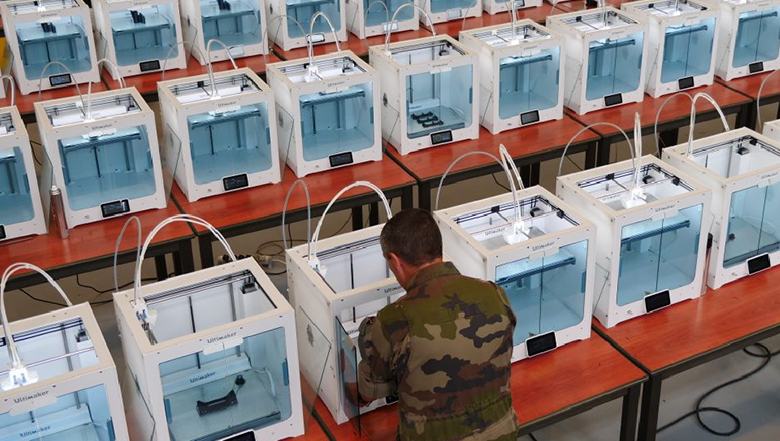
| Printer | Build Volume (mm) | Price Per Unit | Print Monitoring Software | Built-In Webcam | Check Price |
|---|---|---|---|---|---|
| Original Prusa MK4 3D Printer | 250 x 210 x 220 | $1,099 | PrusaConnect | No | |
| UltiMaker S5 | 330 x 240 x 300 | $7,000 | Digital Factory | Yes | |
| Formlabs Form 3+ | 145 × 145 × 185 | $2,500 | Dashboard, Fleet Control | No | |
| Bambu Lab X1-Carbon | 256 × 256 × 256 | $1,700 | Bambu Studio | Yes | |
| Markforged Mark Two | 320 x 132 x 154 | $17,500 | Eiger | No | |
| Raise3D Pro3 Plus | 300 × 300 × 605 | $7,600 | RaiseCloud | Yes | |
Questions to Ask Before You Buy
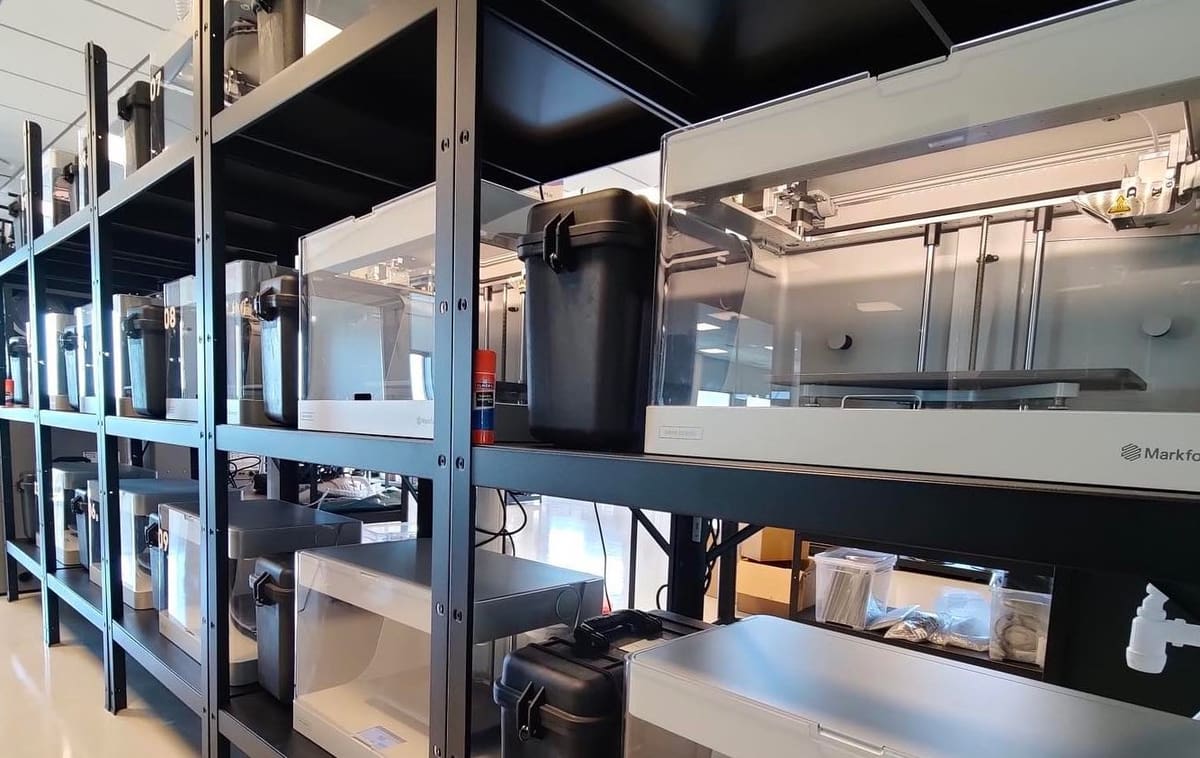
Chances are that you already know the part or library of parts that you’ll be printing. This is an advantage since you can target your 3D printer wish list to the production of those specific parts.
Materials. Consider what materials your products will be printed in. When it comes to 3D printing with filament, you’ll need to consider if you need a printer that offers a hotter extruder that can handle certain engineering-grade materials, such as carbon-fiber-filled nylon or metal.
Complexity. If your parts have a complex design requiring supports, a 3D printer with a dual extruder can print the base material and a support material at the same time. A soluble support material is faster and easier to remove than supports printed in the base material, but requires a wet support removal workstation.
Size. What size are your parts, and how many do you need to print at once? There are two throughput approaches to consider. The one-part-per-printer approach gives you the flexibility to abandon a failed print without too much wasted time and material. If you print multiple parts at once on a larger machine, you could lose all of those parts should any type of printing error happen. On the other had, a large print volume could enable you to print 10s or dozens of parts on once for maximum efficiency.
Investment. A print farm consisting of 50 $400 printers could produce the same amount of parts as a print farm with seven $3,000 printers. For the same overall investment, one option has built-in redundancies but will likely cost more in labor and replacement parts. The second option is more efficient but more costly should one print job fail, ruining several parts. Print farms are ultimately scaleable, and it’s not uncommon to start with 5, then move to 10, then 40. Yet, more companies today are following the numbers in their business plan and investing up-front in the total number of machines that will produce the parts they know they need.
Farm the Same Crop?
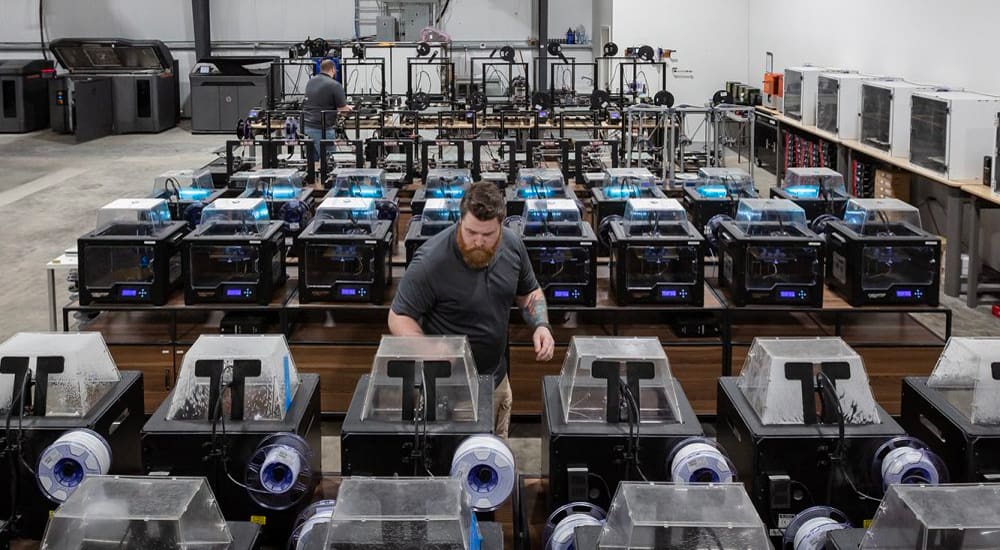
Should all of the printers in your farm but the same make and model?
There are definite advantages to the single-brand approach in terms of having spare parts on hand, the predictability of speed and quality, and training staff on one machine and interface. There’s also the benefit of redundancy, having more of the same printer in backup in case some printers fail or require maintenance.
Yet, there’s also an argument to be made for a mix of printers. This enables diversification in terms of materials and specifications. You could produce a wider range of products with different characteristics, for example, different sizes, resolutions, colors, and materials.
Where To Plant Your Farm
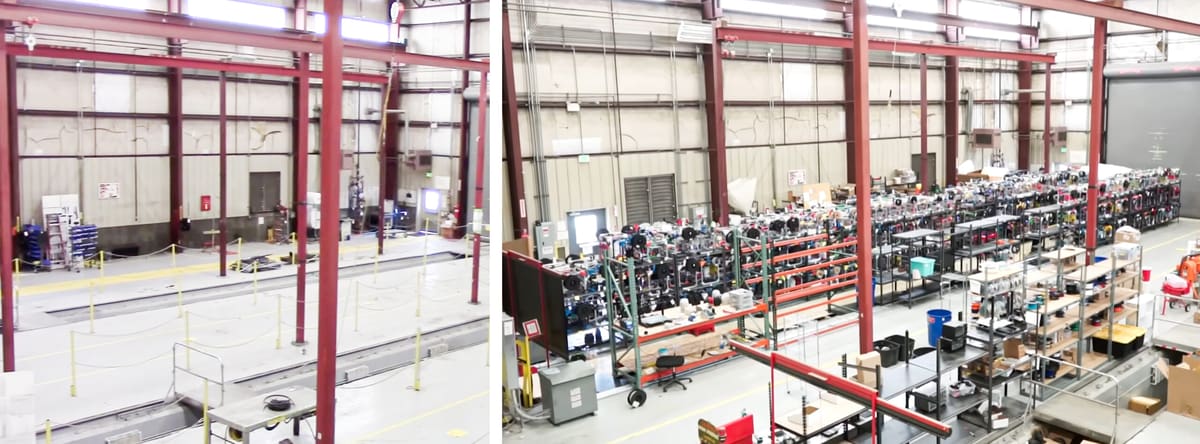
A 3D print farm of more than 10 machines should be located in a commercial space for a number of reasons. First, consider power. Although 3D printers aren’t as power-hungry as other types of manufacturing equipment, you’ll need to calculate the necessary wattage (plus growth) and wire your print farm space accordingly — power outages would be expensive.
Next, consider fumes and temperature. Every 3D printer should be located in a well-ventilated space, which goes exponentially for a print farm. Know your local safety standards and regulations when it comes to fumes and fire suppression. Although it may not be strictly necessary, consider an air filtration system to ensure a safe working environment for you and your staff.
The temperature in your print farm space can get toasty depending on what you’re printing, which may actually be a benefit for your printed parts, but ensure that it doesn’t get hot enough to actually affect printing performance, for example, exceeding the ideal “chamber” temperature listed on your filament. You’ll want to make sure that the temperature is consistent and controllable. One batch of parts printed in a hotter room than another batch could have noticeable differences.
Plan to scale even further with a space large enough to grow. The space unused for now can be optimized for storage. Whatever you 3D print, you’ll need space for post-processing workstations, any additional equipment, packaging and shipping stations, waste collection, and office space.
When it comes to your storage space, ensure you have proper storage for 3D printing materials to prevent moisture contamination or degradation, such as air-tight boxes or moisture-controlled filament closets.
Within your space, organize your printers based on how they’ll be used, either by material, size, or another factor unique to your workflow.
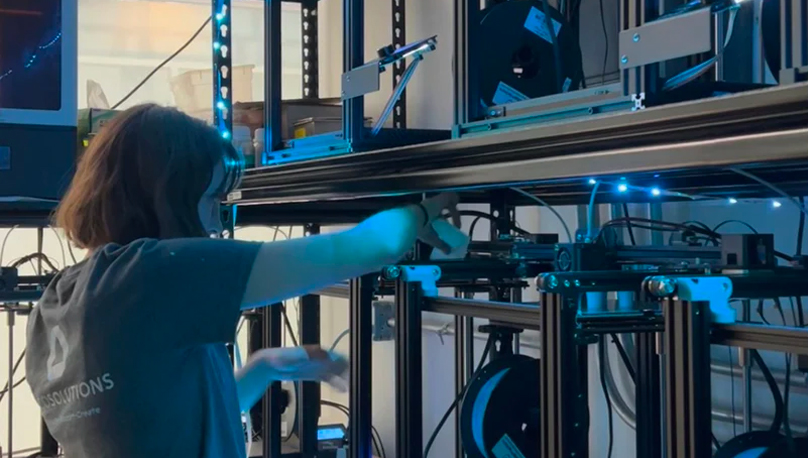
Stay On Top of Maintenance
Prevent machine breakdowns with proactive maintenance. Create a maintenance schedule for cleaning, inspection, lubricating parts, replacing parts (before they fail) and software updates, or better yet, get software that does this for you. Keep a detailed log of all maintenance and outages to identify problem machines or common failures that could be prevented with more, we’ll say it again: preventative maintenance.
Print Scheduling
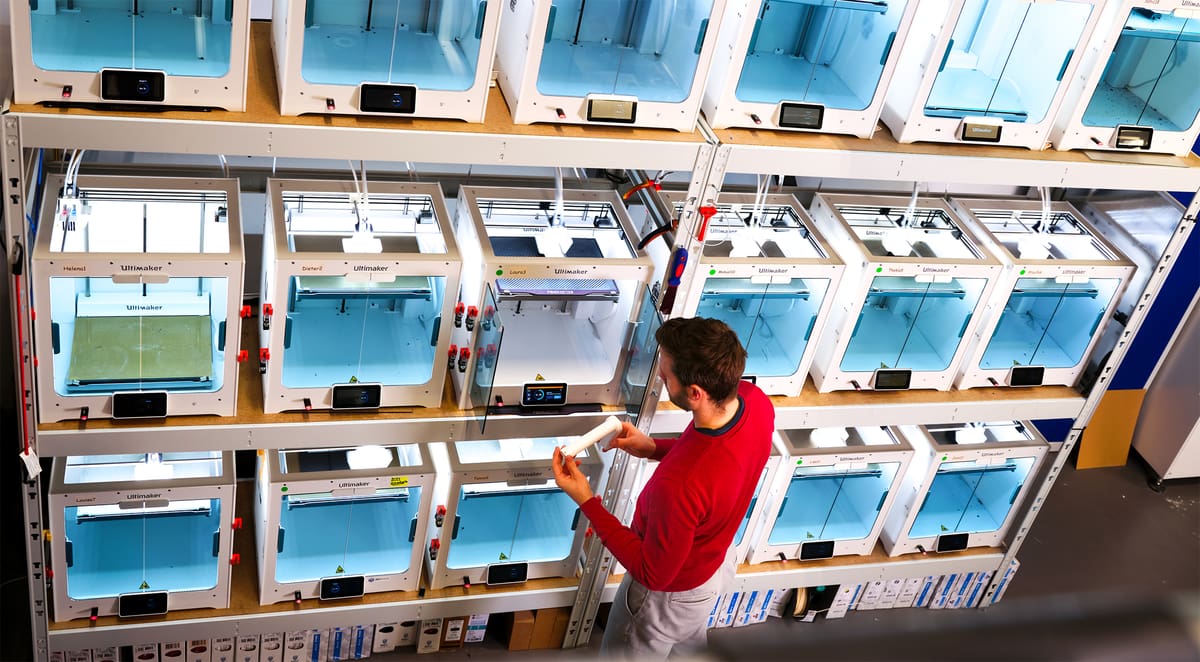
Every printer in your farm is only making money for your business when it’s printing. Your operational costs go up every hour your printer is not being used, so it’s critical to avoid idle printers with smart scheduling of print jobs.
Gaylord says the top piece of advice he gives for setting up a print farm is to focus on organization and workflow from day one. “It’s vital to establish a system for tracking print jobs, maintaining the equipment, and managing filament inventory. A well-organized print farm is easier to scale and can adapt more readily to increasing production demands.”
Employing print farm scheduling software makes this task much easier (skip down to the software section). If you don’t plan jobs efficiently, you could face production bottlenecks and create rushed schedules that result in inadequate time for quality control checks.
Here are essential job scheduling tips:
- Estimate the duration of each print job accurately.
- Place shorter jobs between longer ones to maximize printer usage.
- Schedule long jobs overnight.
- Have a mechanism for prioritizing urgent or critical jobs.
- Group similar print jobs to minimize material changes and setup adjustments.
- Calculate material usage so you’re not running out.
- Have a backup printer or contingency plan for equipment failures.
- Keep logs of actual print farm performance to identify patterns and optimize future scheduling.
Print Farm Software
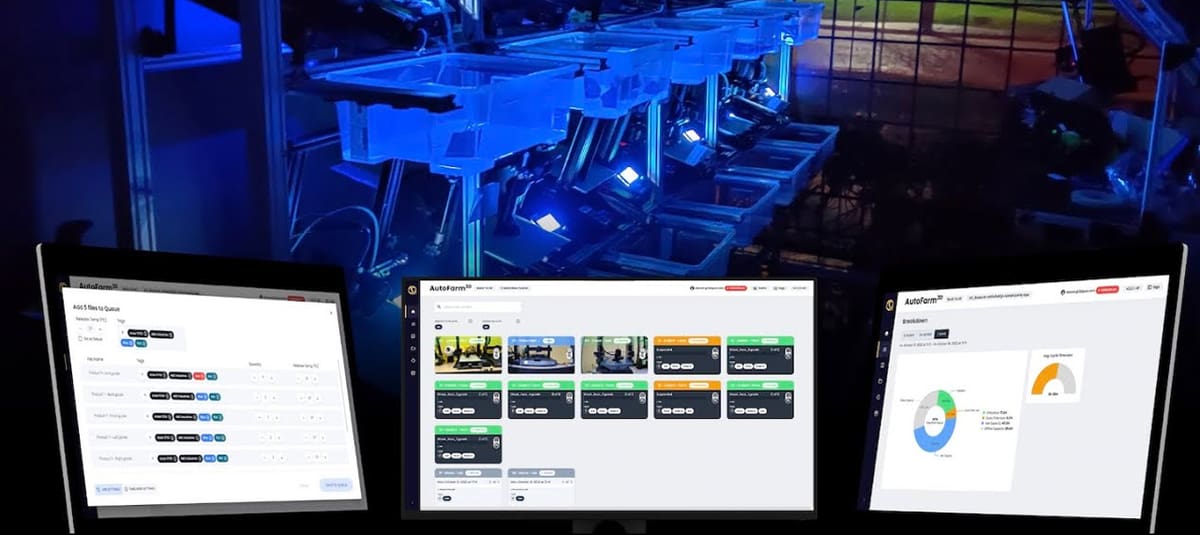
Copying an STL file onto an SD card and walking it over to your printer, loading it, checking that you have the right material and nozzle size onboard, and setting it to print is fine for one printer. It doesn’t work with a farm.
Efficient print farming eliminates every wasted action and potential mistake with software and automation. Printers are machines. There’s no reason to shut them all down when you go home for the day. Aim for 24-7 3D printing that you can monitor and track from a central dashboard on your phone or computer.
At industrial 3D printing operations (think Sculpteo or Protiq) orders come in via their web e-commerce platform, where the customer has uploaded an STL and selected the material. From there, it’s sent to the designated 3D printer matching the job’s perimeters. After printing, it may be removed from the bed by a robot arm, and the software sends the next job in the queue to print. The master dashboard knows where each print job is, how long it took, what material was loaded on what printer, the health of that printer, whether there were any errors, and more. This sort of automation is why prices at 3D printing services are coming down.
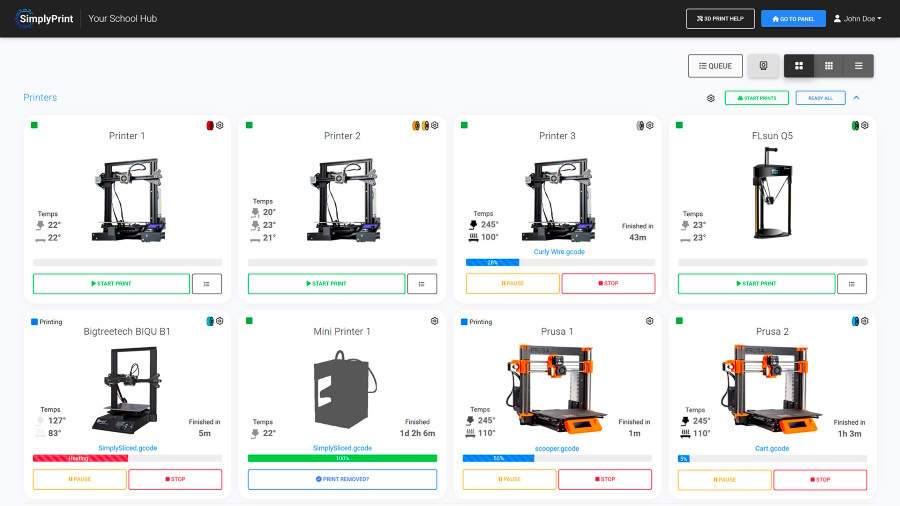
Your print farm may not need this level of automation to be efficient. There is a growing variety of print farm software on the market offering an array of features perfect for entrepreneurial print farms all the way up to large manufacturers with multiple locations. Just note that to link your 3D printer to any type of farm software, it needs to be Wi-Fi enabled or have a way to plug in a USB cable, but still, not every farm software solution will work with every printer.
One software example, AutoFarm from 3DQue, enables operators to manage and monitor tens, hundreds, or thousands of printers from a single dashboard. The system also features auto part ejection capability (added hardware) and traceability to improve and log results, all with live alerts to your mobile. Then there’s SimplyPrint, which features a print queue that tracks how many times files have been printed and how many you still need to print. You can start the same print on several different machines at once and enable “continuous printing, so the software will automatically start the next print. You can store all of your digital files in the cloud and share folders with colleagues.
Boasting even more features is 3DPrinterOS, which includes a slicer for more than a hundred different types of 3D printers, print monitoring, multi-user management, print failure detection, filament tracking, and it will even mange customer billing.
For more options and enterprise wide additive manufacturing solutions check out our guide linked below:
Best 3D Printers for Print Farms
Prusa Research
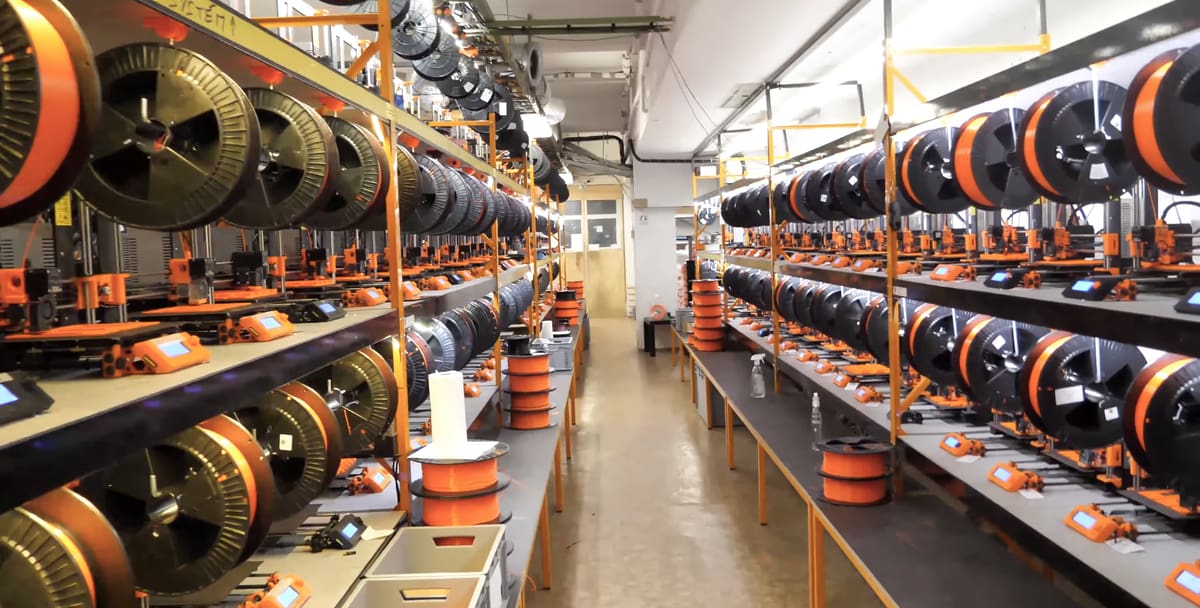
For years and years, Prusa 3D printers have been a top choice for print farms because of their reliability, affordability, and open-source design, which means that users have access to the source code and can modify or upgrade their printers as needed.
It’s not uncommon to find print farmers who have coaded their own print farm software to customize and adapt their Prusa fleet to specific requirements, such as integrating specialized sensors not natively supported by the standard firmware, fine-tuning print parameters beyond what is available through standard settings, or modifying the firmware source code to better integrate and communicate with a custom software infrastructure.
The ease of maintenance and repairability is another strong reasons why print farmers choose Prusa. Parts are easily accessible and replaceable, rather than hidden behind panels or glued in place. Another aspect of Prusa 3D printers that make them a good choice for a 3D print farm is that so many people using them for this purpose that there is a large community to turn to for troubleshooting, sharing experiences, and learning from other print farmers.
Prusa printers are designed with upgradability in mind. You can easily upgrade components or add new features over time, so your investment isn’t obsolete when a new printer version comes out.
Prusa provides its own slicing software called PrusaSlicer with a user-friendly interface and profiles that can help streamline the printing process in a print farm setup. Some Prusa models support multi-material and multi-color printing, allowing users to create more complex and visually appealing prints. This feature can be an advantage for producing diverse objects in a print farm setting.
PrusaConnect is cloud-based software you can use to run your print farm remotely. You’ll need to add your own webcams for print monitoring, since these printers don’t come with one built-in. The software enables you to queue and distribute print jobs, store a history of what’s been printed, browse old projects, and track filament consumption. PrusaConnect transfers all files encrypted. Unlike cloud-based PrusaConnect, PrusaLink is a web service running locally on your printer, accessible from local network.
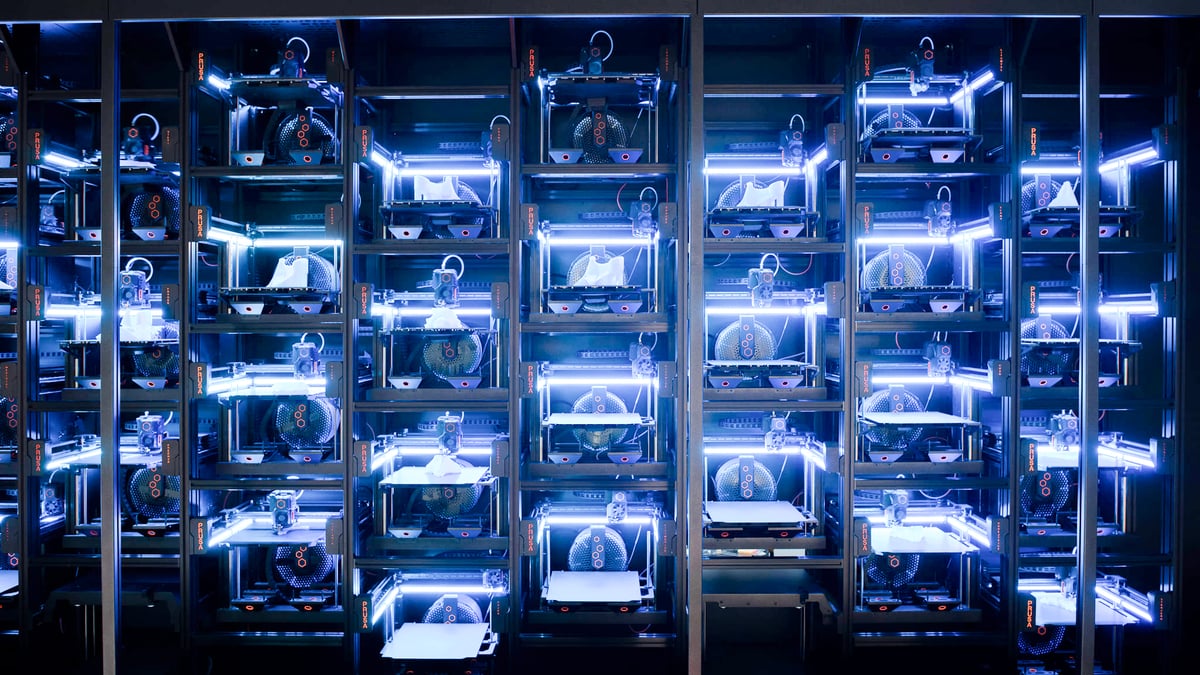
A little over a year ago, Prusa Research announced the debut of a print-farm-in-a-b0x concept called the Original Prusa Pro Automated Farm System starting at around $50,000. The AFS includes 34 Original Prusa 3D printers, internally developed farm management software, and automatic collecting and delivery systems, maintenance plans and training courses, and on-site support and immediate printer replacement service. In 2023, the concept was overhauled, Prusa says, to feature an Intelligent Shelving System, which involves a robotic arm to moves an entire print sheet to a modular shelving system, while keeping in mind the height of the print. The system also ensures full print traceability via QR codes on the print sheets and features an optical monitoring system with image recognition for automatic print issue detection. But don’t get too excited, the systems is just now being installing at the first beta-testing customers. We’ll keep you updated on its actual commercial launch date.
Other Prusa Printers for Farms
There are lower-cost Prusa printers that are comparable in reliability. The MK4 Kit is a version that does not come assembles and saves you about $300 per printer. There’s also the smaller MK3 for $900 or $650 not-assembled.

Learn more
UltiMaker
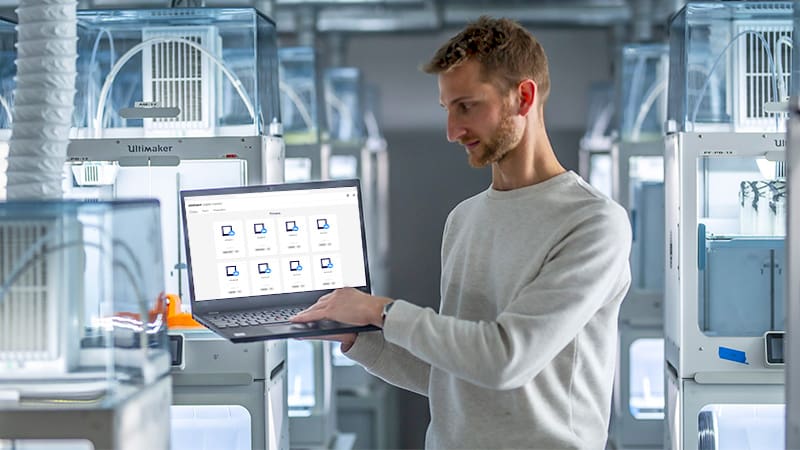
Ultimaker 3D printers are widely used for print labs in schools and universities, as well as print farms for prototyping and manufacturing.
There are several reasons Ultimaker 3D printers are a good choice for a 3D print farm environment, primary of which is reliability and build quality. Plus, there’s the huge material selection including metal.
Ultimaker printers are generally known for their robust construction and user-friendly interface. Especially the S-Series printers (S3, S5, S7) are known for producing high-quality and consistent prints with fine details and precision. They have an open material systems so you can pick basically any material you want including a wide range of third-party filaments that come with established print profiles.
UltiMakers feature dual nozzles with interchangeable print cores enabling easy printing with support material and you can switch between different nozzle sizes by just popping out one and clicking in another (also a quick remedy for a nozzle clog). The optional filament changer enables you load four spools of filament so you’re sure to not run out overnight or it can be used for multi material prints.
Like Prusa, Ultimaker has an active and supportive user community, plus a large collections on online tutorials, an optional priority support subscription, and a training program called UltiMaker Academy.
Software is an advantage with UltiMaker not only because this company created, Cura, the widely used slicing software, but because it offers software to manage print queues and farm printing operations, so you don’t need third-party software.
Ultimaker printers come equipped with features for network connectivity and remote monitoring, plus for an extra subscription called the Ultimaker Digital Factory, which enables everyone on your team to send jobs to a central print queue and store print files in a secure library of parts that can printed elsewhere in your organization, even across the globe. All UltiMaker software has the security certification ISO/IEC 27001.
Other UltiMaker Printers for Farms
The UltiMaker S7 ($8,300) is also a good choice for a print farm. The UltiMaker S7 features more sophisticated temperature controls for tight tolerances on engineering-grade materials, a flexible build plate, an integrated air filter, and better auto bed leveling. The smaller S3 is another farmable option from UltiMaker at $4,500 each.

Formlabs
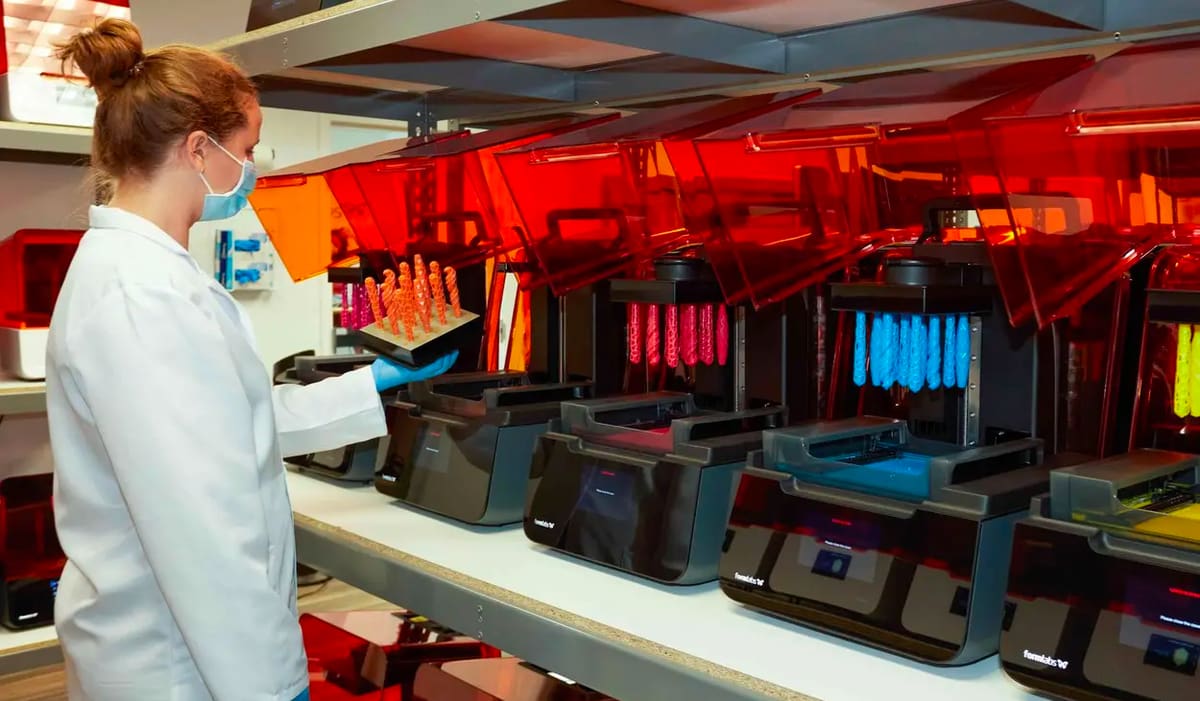
Yes, you can also farm resin 3D printers and the Formlabs Form 3 is an ideal choice. These stereolithography (SLA) printers are known for producing high-resolution and intricate prints in a wide range of materials.
Because the Formlabs resin materials come in convenient, no-mess cartridges you don’t have the hassle of pouring liquid resin from a jar and getting it everywhere. There are more post processing steps with resin printing, such as washing and curing parts, which would require more space than FDM technology, but Formlabs boasts plenty of farms among its userbase. In fact, the company offers a “Factory Solutions Team” to help you plan and build your farm (for a fee) and even create custom materials just for your needs.
Another reason to consider Formlabs is their new automatic part removal system. The Formlabs Automation Ecosystem (an additional $3,400 per unit) is a hardware and software solution that promises to reduce cost per part, and drastically reduce manual labor, the company says. The part removal involves an arm that grabs the final build tray and deposits the parts into a bin and puts the build tray back so it’s ready for the next job in the queue. There’s also a Automated Resin Handling systems to ensure you have enough resin to print through the night or weekend.
Formlabs offers a wide range of resin materials from dental materials to robust manufacturing materials all in proprietary formulations. On the one hand, this ensure consistency in materials leading to repeatability and reliability, but you are locked into to their menu of materials.
Formlabs offers PreForm, a pretty user-friendly slicing software along with a print monitoring and control software called Dashboard at no extra subscription cost. Dashboard lets you follow your prints online, track consumables and service coverage, organize printers and manage access, and get notifications when a print is finished. A step up from Dashboard is a subscription software called Fleet Control. As the name implies, this is your farm manager. With this you can automate and optimize your workflow for maximum fleet productivity with features including real-time information on all print jobs in customizable dashboards, individualized user permissions and access levels, and an option to update all your printers to the latest firmware automatically.

Learn more
Bambu Lab
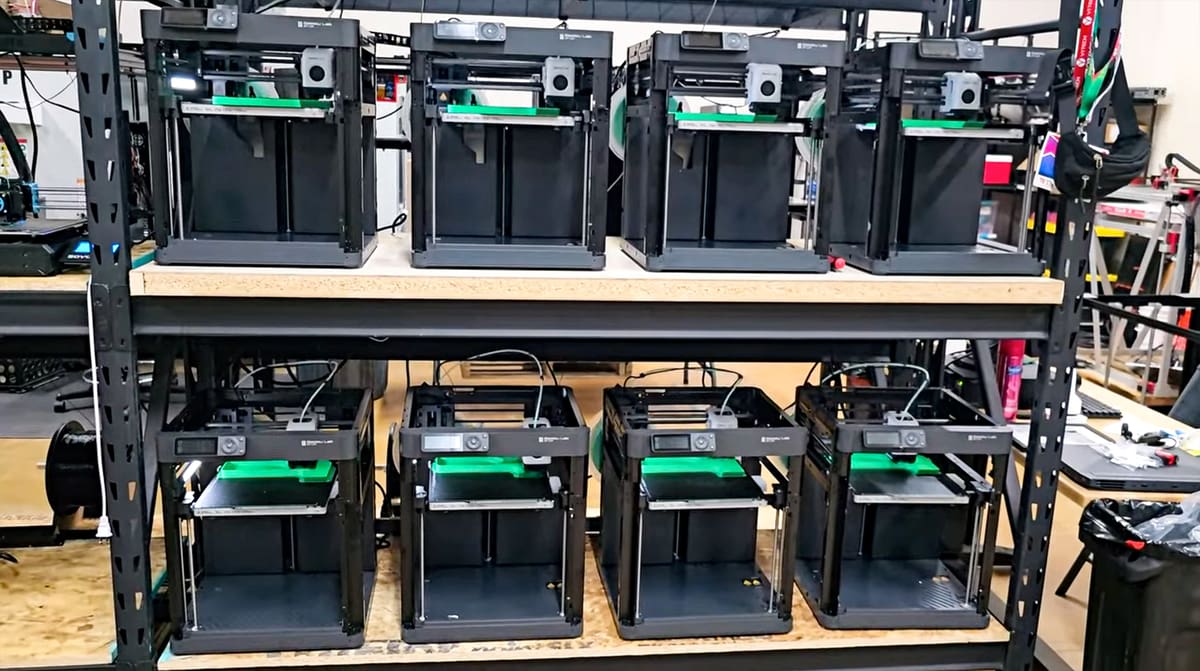
The new kid on the block Bambu Lab is becoming a popular choice for farms because of its printers’ speed, ease-of-use, and reliability. These printers, especially the X1 series with a large, easy-to-use touchscreen interface along with the intuitive Bambu Lab slicing software, have all but revolutionized desktop 3D printing, making it far easier than ever.
With Bambu Lab printers you have a wide range of materials to choose from as well as an optional four-material changer for multi-material parts and parts with soluble supports. There’s an embedded camera, a Lidar sensor to detect failures, and a filament odometer, so you know how much material you have.
As good as the Bambu Lab printers are when it comes to speed and reliability, they are not inherently designed to scale, like Prusas or UltiMakers. This doesn’t mean that they can’t be a great farm solution, but your software options to manage prints queues and track jobs and materials are underdeveloped at the moment, yet something the company says it is working on.
You can send prints by Bambu Studio software and control your printer anytime anywhere with Bambu Handy, but the software doesn’t enable you to send print jobs to the cloud to be printed on the next available printer or send a print to multiple printers.
Farm software maker 3DQue has a beta version of its AutoFarm3D now available to manage Bambu Lab X1C, P1P, and P1S printers in LAN mode. 3DPrinterOS, a cloud-based 3D printing management platform, also says it integrates with Bambu Lab machines.
Other Bambu Lab Printers for Farms
In our experience with Bambu Printers here al All3DP, they all have the same high reliability so the lower cost machines, such as that P1P ($700) are also good farm options. The newer X1E version ($2,500) enables Ethernet connectivity and an actively heated chamber to manage more engineering grade materials, such as carbon- or glass-fiber-reinforced ABS.

Learn more
Markforged
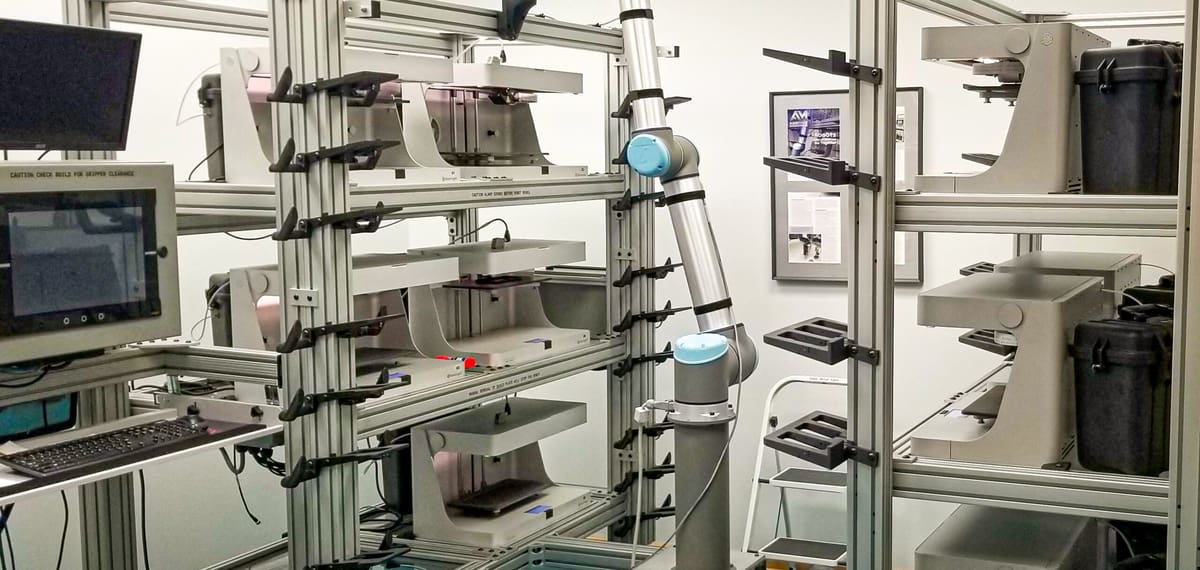
Markforged is known for producing industrial-grade 3D printers, and several features of their printers make them a good choice for a 3D print farm environment especially for durable industrial parts made from carbon-fiber nylon.
Markforged makes several printers, but the one we’ve seen farmed the most is the popular Onyx Pro and the Mark Two (Gen 2) machine, which has the capability to reinforce prints with continuous fiber materials like carbon fiber, fiberglass, and Kevlar. This strength and reinforcement make the Mark Two ideal for producing jigs and fixtures, shop tools, spare parts, and more. Both the Onyx Pro and the Mark Two have the durability essential for continuous 24/7 operation in a 3D print farm.
Markforged printers only print with Markforged materials (nylon, PLA, TPU), which isn’t necessarily a disadvantage. The company’s black Onyx materials, a carbon-fiber reinforced nylon, has been proven in thousands of printers for years, so it’s as reliable as it gets. Reinforce Onyx with continuous carbon fiber and you get mindblowingly strong parts. You can see our hands on with this machine in the article below.
There’s some handy features on Markforged printers any print farmer will appreciate, including how the machines use the weight of the filament spool to estimate when it will run out so users can get the most out of their material. On the hardware side, the kinematic coupling that secures the build plate of all Markforged printers allows the plate to be removed and re-installed with up to 10 micron accuracy. This minimizes the need for bed re-leveling so less time is spent calibrating and more time is spent printing. The hardware is designed for continuous use so all printers are prepared to run for long hours without risk of overheating or mechanical failure, the company says.
Markforged printers are designed to farm from the ground up especially when it comes to software. You won’t need any third-party software to store and organize your digital inventory, manage your fleet from your desktop, or track maintenance and materials on devices, since the company’s basic Eiger software handles all of this.
Upgrade Eiger to other tiers and you’ll get more features, such as batch print presets that automate repetitive tasks, the ability to custom analytics, such as real-time ROI visibility, part approval workflows for collaboration teams, user authentication and encryption, and a tool to manage print requests from across your organization.
Other Markforged Printers for Farms
There are lower-cost Markforged printers that are comparable in reliability and produce strong, industrial carbon-fiber nylon parts, just not with continuous carbon fiber. Onyx One is about $9,000. On the other end of the scale is the new shop-floor FX10 with a lot more sensors and automation.

Raise3D
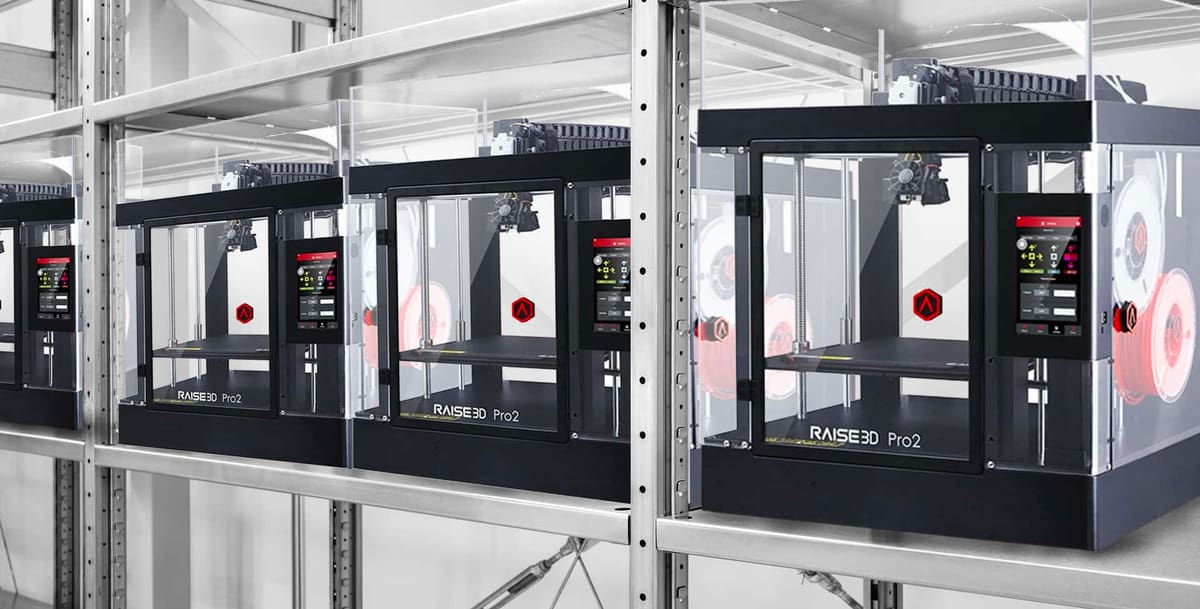
Raise3D printers are known for their reliability and large-build volumes, plus dual-extrusion capabilities. If your part size requires that you go bigger than the printers above, a Pro3 Plus (300 × 300 × 605 mm) is a good bet. Plus, because it features dual extruders, it’s easier to print with a base material and a support material at the same time.
The Pro3 Plus has all the automations and features you’d want in a farm machine: auto bed leveling, integrated webcam, Wi-Fi and ethernet, plus Raise3D printers typically feature user-friendly touchscreens and interfaces, making them easy to operate.
Another big plus is the open material platform, so you can essentially print with any material you want, including standard thermoplastics and advanced materials, which benefit from the Pro3’s enclosed environment. In the event of a power outage or unexpected interruption, there’s a “resume printing” functionality.
Raise3D printers feature remote cloud-based monitoring and control software called RaiseCloud. This enables you to oversee the printing process, receive notifications, and manage the printers from a centralized location. There’s no limit to the number of users, printers, or print tasks. RaiseCloud is designed and built with enterprise standard data security in mind, the company says, featuring encryption for printers, high performance AWS server firewall, and key authentication for file transfers. There’s even a RaiseCloud mobile app so you can carry your print monitoring around with you.
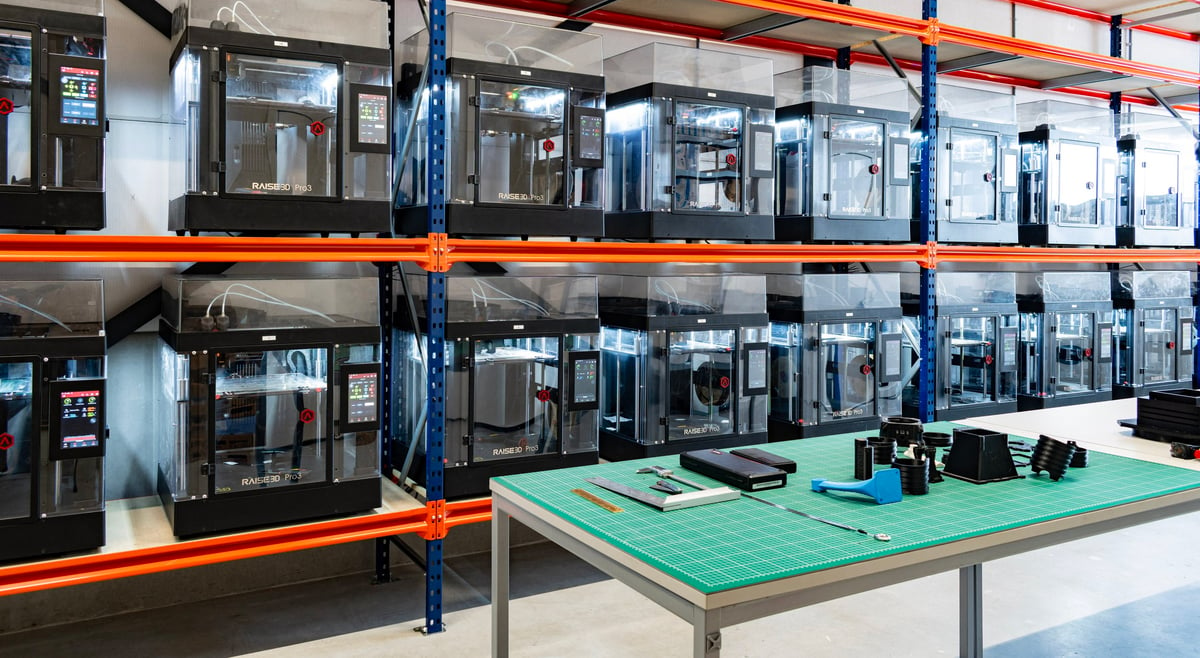
A final checkmark in the pro column for Raise3D is the company’s broad array of printers and technologies. If your company or print farm wants to have FDM, resin, and metal 3D printers all on the same ecosystems, this company offers them all.
Other Raise3D Printers for Farms
Working with Raise3D you can mix and match your farm to include the company’s metal FDM 3D printers, the Raise3D Forge1 or the MetalFuse. You can also add the company’s new resin technology the DF2 Solution.

Print Farm or Print Service?
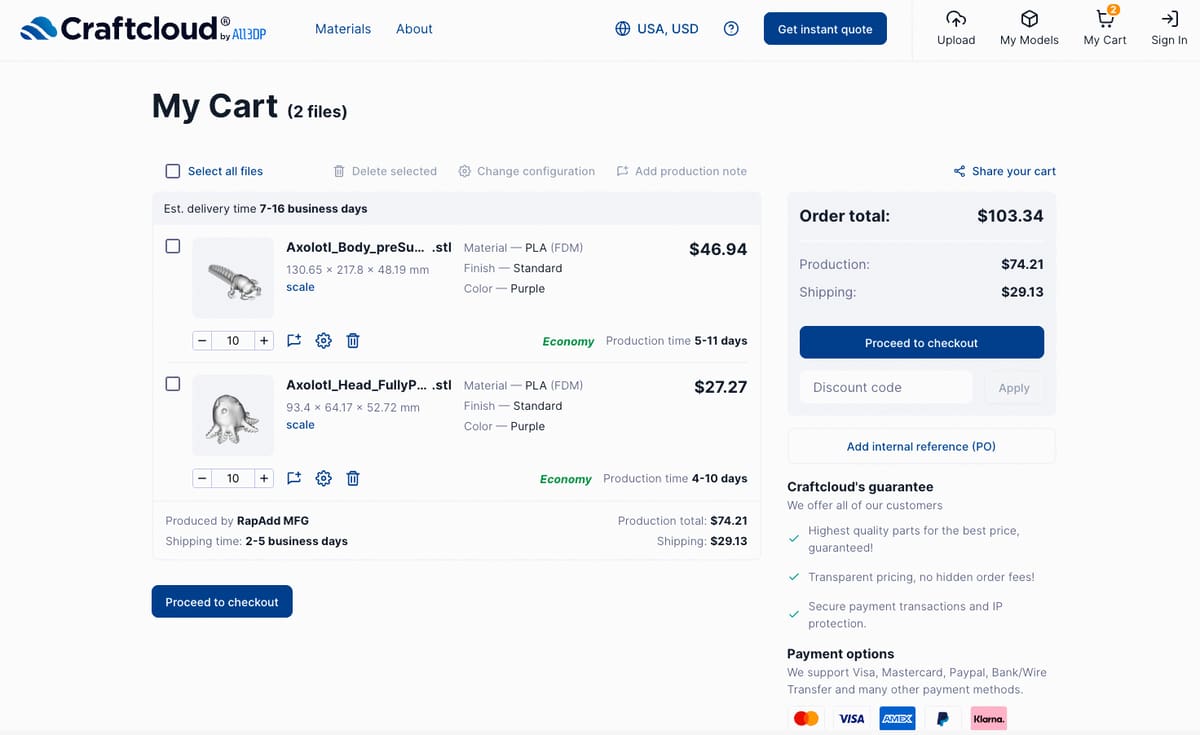
Would outsourcing your 3D printing be faster or cheaper? This is a question everyone considering a print farm should ask themselves. Even if the answer is no, it’s a good idea to find a 3D printing service that could handle your printing should you experience printer outages, rush jobs, or sudden volume spikes.
Advantages of Print Services
There’s the obvious advantage of no investment in equipment, materials, space, time, or labor, but contracting to a 3D print service isn’t 100% risk-free. You’re not in control of printing and you lose a bit of the flexibility to instantly change designs or materials. You also have to account for the service’s turn-around time and shipping and you may have fewer options in materials.
On the other hand, you don’t have to worry about failed prints, wasted material, power outages, or staff shortages.
Fortunately, the cost comparison is easy to make. Print services marketplaces, such as Craftcloud, provide instant quotes on your print job from a range of service providers, enabling you to select various materials and 3D printing technologies. Upload your STL file, select your material, finish, and quantity and you’ll be given a range of options.
For example the 10 axolotl figurines above will cost about $100 including shipping. You’d have to sell them for more than $11 each to even make a profit, which is probably to expensive. On the other hand, you can get 35 of these spare parts (below) printed in durable carbon for just over $400 and delivered within two weeks or faster with a rush charge. For this volume and material, it might make more sense for larger companies to order than establish an in-house farm depending on how often and how much you calculate you’ll print.
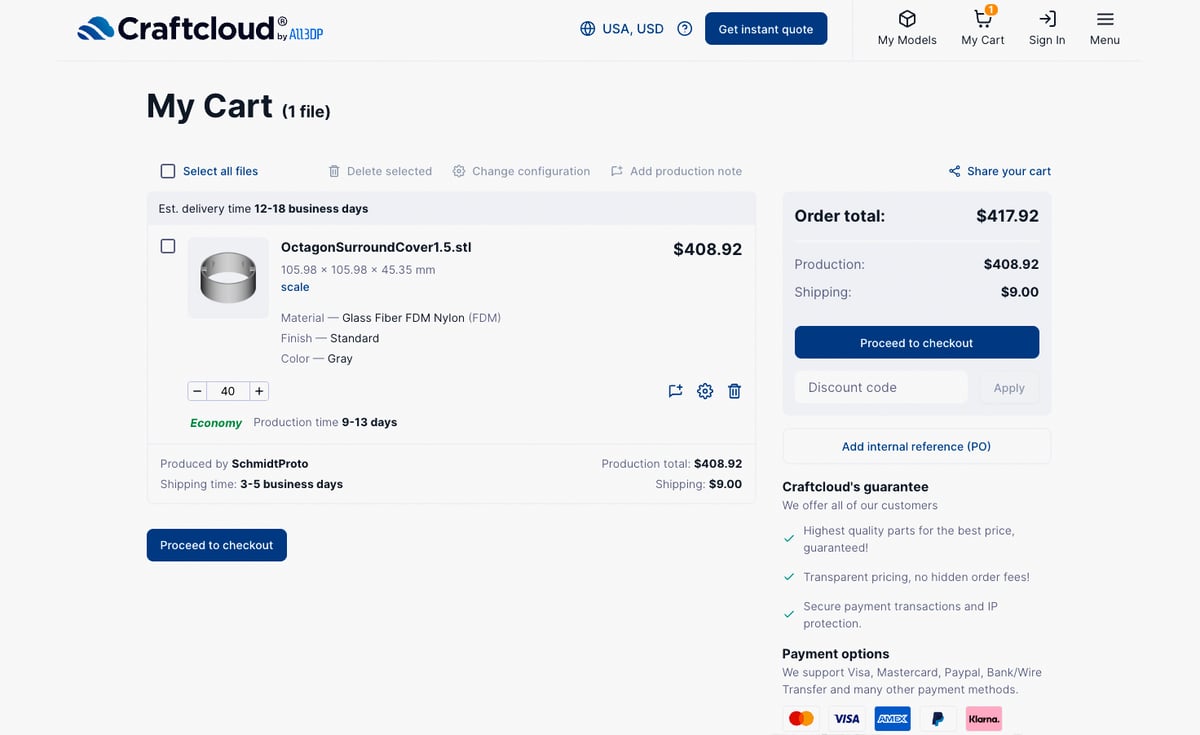
Even if you have your own farm, a print service may provide you with easier shipping of large orders or a printing option closer to your customer, which are to additional important points to consider.
License: The text of "The Best 3D Printers for Print Farms" by All3DP Pro is licensed under a Creative Commons Attribution 4.0 International License.
CERTAIN CONTENT THAT APPEARS ON THIS SITE COMES FROM AMAZON. THIS CONTENT IS PROVIDED ‘AS IS’ AND IS SUBJECT TO CHANGE OR REMOVAL AT ANY TIME.





